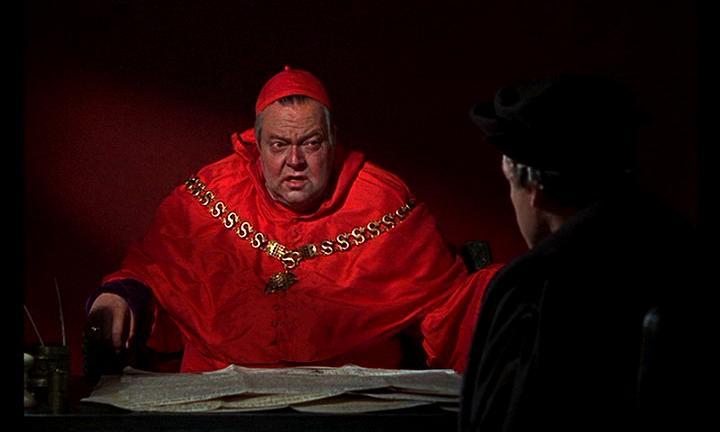Second #2108,35:08, Image © Studio Canal
Today’s frame pairs the elusive Doctor Winkel with one of the many small sculptures dotting his home. Both frozen in this frame, both avoiding our camera-eye and looking off screen, their carved faces seem to offer us equivalent amounts of knowledge. The secretive and plainly elusive/dismissive Winkel is pushing his way through his conversation with Holly much the same way as this statuette would, providing no new information; the only truth to be drawn here can be found studying the lines of these two whittled faces. Winkel’s harsh temperament is, in itself readable, but only to detect some underlying sense of hostility, like a statue holding a sword or mounted on horseback. In many ways, Winkel and this hardwood idol are more alike than either might know.
The presence of this idol, though, may tell us even a little more about Winkel–and Vienna–than we already know. In 1949 Vienna was like much of Europe: overwhelmingly Roman Catholic. A census in 1961 found that more than 90% of the population was Catholic, and yet we have not stumbled upon a church, a priest or nun, or really any type of religious iconography thus far. In a city literally full to the brim with Catholics, one would assume that finding a cross hung on a wall or around one’s neck would be so ordinary as to become invisible, yet in The Third Man‘s Vienna, it has become literally invisible. Some of this might be connected to this film’s tenure. The antipathy between the Anglican and Catholic churches is no secret (in fact Orson Welles played a cardinal in a film about it in 1966) and that self-same anti-pope sentiment was very strong in the United States until the election of JFK in 1960. But yet, in a film so deliberate in portraying the gritty underground and black market in postworld Europe, it seems antithetical to ignore religion completely.

But to ignore religion and discount it is not to take away its power, or the power of the religious morality to infect secular morality. Indeed, many of the moral decisions in this film stem from positively religious starting point. Holly’s crusade to discover the secrets behind Harry’s murder can be linked back to the ten commandments, specifically his distaste with someone breaking the “though shalt not kill” prohibition. Holly also seems particularly peeved by those who “bear false witness”, whether it’s Kurtz and Winkel’s concocted series of alarming coincidences, or the Porter’s unwillingness to bear witness at all, it is the breaking of this commandment that rankles Holly’s moral code. Even the uncanny feeling implicit in today’s frame can be traced back to that ancient pair of stone tablets, since we see Winkel’s posturing reinscribed in the form of a “graven image” or perhaps a “false idol” built into the frame itself. So, despite its marked lack of explicit religion, this film is full of an invisible religious fervor, directing aspects of the plot from some internalized location within.
Another Viennese man pondered the way that religion wormed itself into every aspect of civilization. Sigmund Freud, raised an orthodox jew rather than a catholic, wrote this of religion:
“Religion restricts this play of choice and adaptation, since it imposes equally on everyone its own path to the acquisition of happiness and protection from suffering. Its technique consists in depressing the value of life and distorting the picture of the real world in a delusional manner–which presupposes an intimidation of the intelligence. At this price, by forcibly fixing them in a state of psychical infantilism and by drawing them into a mass-delusion, religion spares many people an individual neurosis. But hardly anything more.(Civilization and its Discontents, Norton, 1961, pg. 34)”
Perhaps this was meant to be as contemptuous as it seems, but it is possible to read another way. For if we imagine The Third Man it stripped of its religious potency it becomes plain that it is a recipe for neurosis. Imagine Holly, stranger in a city where he knows no one and understands nothing, with his only link to this world (Harry) killed before his arrival. Without his wild drive for justice, retribution an honesty–those things granted him from his decidedly religious morality–Holly would be a friendless victim awash in this lonely city, and would be primed to start losing his mind. So in a sense, Freud’s words ring very true. It is exactly his religious “infantilism”–that “mass-delusion” to which he knowingly or unknowingly subscribes–that saves him from an individual neurosis or psychosis.
Back to our frame today, and its inherent religiosity, we can see those two figures as almost allegories, Winkel for bearing false witness and the statuette for worshipping false idols, but the empty space between them is occupied by the invisible presence of religion. It is this invisible presence that holds today’s frame together and it is that selfsame moral code that holds The Third Man together. What appears on the surface to be a completely secular film is simply one that has internalized its religious code, and by hiding it that code becomes even stronger.
Over the absolute length of one year — two times per week — Still Dots will grab a frame every 62 seconds of Carol Reed’s The Third Man. This project will run until December 2012, when we finish at second 6324. For a complete archive of the project, click here. For an introduction to the project, click here.
Get Walker Reader in your inbox. Sign up to receive first word about our original videos, commissioned essays, curatorial perspectives, and artist interviews.
